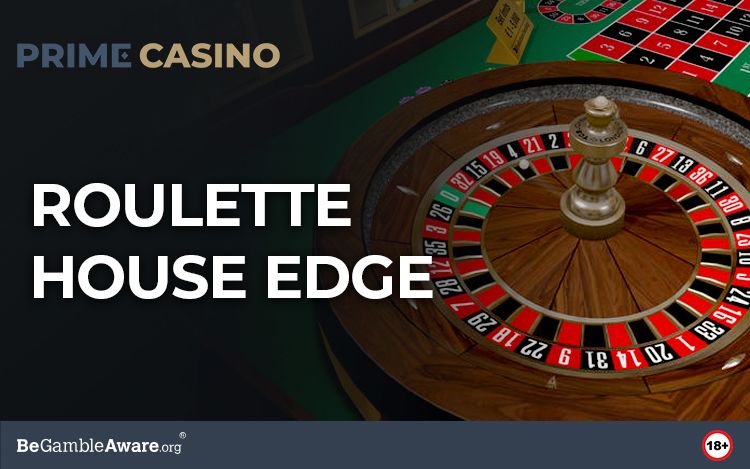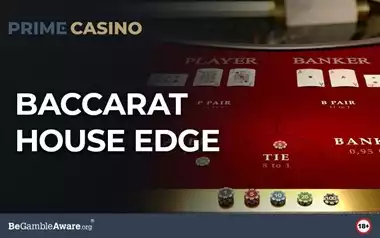Roulette began in the 17th century, came to casinos in the 1800s, arrived online in the late 1990s, and today is enjoyed in live varieties and a greater range than ever before. New systems, like in online casinos, are developed monthly, providing roulette fans with more possibilities, meaning players can enjoy European, American, French, and other roulette varieties whenever and wherever they like.
In today's article, we'll take a closer look at roulette from the perspective of its house edge, learning what it is and how it impacts gameplay.
What is House Edge?
So, let’s start by asking: ‘what is House Edge?’ Put simply, it is the mathematical edge that a casino table game, such as roulette, has over the player. This edge guarantees the venue a certain percentage return over the long term.
The other side of the coin is the return to player (RTP), which is the percentage of their wager players may get back over the long term. The return to player is calculated by subtracting the house edge from 100%. So, if a game has a house edge of 2.8%, the RTP will be 97.2% (100% - 2.8%).
The house edge exists because, otherwise, outside of hospitality in the case of real-world casinos, the casino would make no money. As a business and not a charity, the house edge helps the gaming provider pay for things like providing the games, paying the staff, keeping the casino or club in good shape, offering online improvements and innovations; and the list goes on.
Of course, one thing to note in regards to both return to player and house edge is that neither value is guaranteed, nor is it representative of just a few rounds or hands of a game. Instead, it is a statistical average calculated by observing the data over hundreds of thousands of games. Due to how broad the field of reference is, this allows players to sometimes ‘defy the odds’ and land a jackpot or a winning streak, while on the flip side, there will be an unfortunate player having the worst luck that day—meaning statistically, everything balances out.
Due to the impossible-to-predict nature of chance-based games, however, it is important to view these percentages as guidelines to compare to other games, and not as a guaranteed figure set in stone. Otherwise, you’d see players walking out from a £100 wager on a 2.8% house edge game with £97.20 time after time.
How Does House Edge Work in Roulette?
Because of its segmented wheel and structured betting format, roulette is the ideal example for exploring house edge. In European and French Roulette, which have one zero, there are a total of 37 numbers (0+36 numbers) on the wheel. This means that the ‘pill’ (the ball) can come to a stop in any one of the 37 different locations. Because of this, the probability that you will select one of those options is 1 in 37, while wagers like red/black that cover half the wheel have a 47.4% likelihood (due to the green zero) and have their payout rounded up to 1:1.
However, while the odds of a straight-up wager, which is a bet on a single number, are 1:37, the payout ratio from the house is 35:1. As a consequence, the house will have a house edge of 2.7% over players in the long term. Understanding the in-depth details of mathematical statistics for roulette is not essential, but it is helpful to have a general knowledge and awareness of how the payouts of the game and their odds are formed.
How to Play Roulette?
Roulette can be played in three simple steps:
Step 1: Choose Game
Select the online roulette game you want to play at Prime Casino. You'll also find options such as live dealer roulette.
A typical roulette comes in three main types:
- European Roulette offers a 2.7% house edge and 37 numbers plus one 0.
- French Roulette has 37 numbers plus one 0, a 1.35% house edge, and distinctive side bets like ‘La Partage’ and ‘En Prison’ on the French-language table.
- American Roulette contains 38 numbers and two 0s with a 5.26% house edge. It has the ‘basket’ bet and sometimes the 'surrender' option.
Load the game on your chosen device, including mobile ones.
Step 2: Understand the Table and Bet
Bets in roulette fall into three categories:
- Inside Bets: These are bets on a single number (a ‘straight-up’ bet) or a series of numbers (split, street, corner, six line, basket in American roulette).
- Outside Bets: Bets on categories of numbers like red/black, odd/even, high/low, column, or dozens.
- Call Bets: Also called ‘announced bets’ or ‘special’ bets, these vary across types. French Roulette calls one call bet Orphelins, while European Roulette calls it ‘The Orphans’.
Place your chips (virtual or real) on the roulette table's proper region to bet. You can gamble numerous times per round by placing chips in multiple zones.
Step 3: Spin the Wheel and Reveal the Winner!
When no further bets are called, the dealer spins the roulette wheel (or RNG software spins it) and drops ‘the pill’ into it. When the wheel slows, the pill skitters around, and the winning portion is determined from where it stops.
The next round of roulette begins after all winning bets are paid.
How Does Roulette’s House Edge Vary From Other Casino Games?
The average house-edge statistics for the most common casino games are as follows:
- Blackjack: 0.50%
- Baccarat: 1.06%-14.36%
- Online Slots: 2%-12%
- Video Poker: 0.5%-5%
Roulette’s house edge is unique thanks to the three distinct variants. Therefore, the overall house edge range for the game is 1.35%-5.26%, making the overall range comparable to video poker, but how this feels during play is more akin to baccarat or online slots, which have ranges of over 10%.
Thanks to its additional bets, French Roulette offers the lowest house edge of around 1.35%, while European Roulette has a house edge of 2.7%. While the house edge differences between these two variants feel minimal, the simple change of an additional 0 sees American Roulette’s house edge soar to 5.26%. This is why, among players, unless they are looking for a specific ‘Vegas style’ experience, where French and European Roulette are offered, American Roulette is best avoided.
Is it Possible to Lower the House Edge in Roulette?
Roulette and all other games, even live casino ones, are games of chance, thus no one can forecast or guarantee results; at least not in a legal way. While the house edge statistic does not account for the short-term fluctuations of random chance, it is true that in the long term, the house always wins.
Playing optimally—such as avoiding ‘sucker bets’ like the ‘basket’ bet in American Roulette—can maintain the best possible RTP (and therefore lowest house edge), but the player cannot improve on the statistics already presented.
Takeaway
To clarify, the house edge and accompanying RTP percentages are statistical averages indicating the expected outcome across thousands of players and thousands of rounds of roulette. Players can use these percentages as an indication of games which theoretically could be more rewarding than others, but due to the fluctuations seen in the short term, these statistics should be used as advisory figures only.
When playing roulette and any casino game online, the most important thing is to always practice responsible gambling. Set yourself a budget and a time limit for your session and stick to it. Never risk more than you can afford to lose, and when the fun stops, stop.
If you’re ready to watch the roulette wheel spin, then sign up and play today right here at Prime Casino, where a premier selection of the best roulette games awaits.








